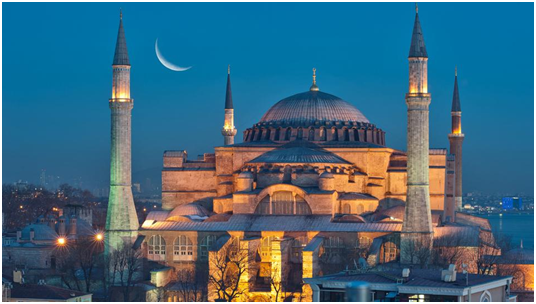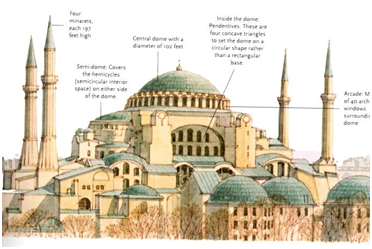

Context
Hagia Sophia has survived through various transformations, it has been a cathedral, a mosque, a museum, and now back to being a mosque. After being opened as a mosque, the site has hosted over 6.5 million viewers in the last two years.
About
About the Site
- The Hagia Sophia is a historic place of worship in Istanbul, Turkey, in Eastern Europe.
- It is the national landmark of Turkey, located at the center of the capital Istanbul.
- It was built by the Roman empire as the basilica in 537 AD.
|
Church
|
- Hagia Sophia was originally built as the Greek Orthodox Christian patriarchal Basilicain 537 AD by the Byzantine Roman empire during the reign of Jutinian I.
- Converted into mosque: It was converted into a mosque by the Mehmed the Conquerer of Ottomon empire in 1453.
- Converted into museum: It remained a mosque until 1931, and was opened as a museum in 1935 by the Republic of Turkey.
Structure of the Heritage Site
- The Hagia Sophia measures 269 feet in length and 240 feet in width, with the domed roof stretching 180 feet above the ground.
- Architectural Style: It was built in a grand Christian basilica style and is the most significant surviving example of Byzantine architecture.
- Columns: The Hagia Sophia has 104 columns, many made of marble, imported from the Temple of Artemis in Ephesus—an ancient city near modern-day Selçuk, Turkey—and from Egypt.
|
It was enlisted in the world heritage site by UNESCO in 1985. |
- Dome: The main nave is covered by a central dome that is 107 feet in diameter and rises 180 feet above the ground
- Minarets: The four minarets surrounding the main dome were later added by the Ottomon empire.
- One minaret was built out of red bricks while the other three were built of white limestone and sandstone.

- One minaret was built out of red bricks while the other three were built of white limestone and sandstone.

